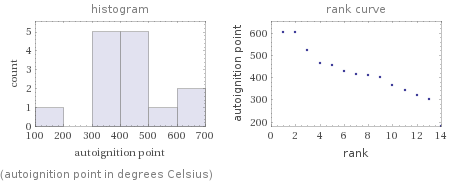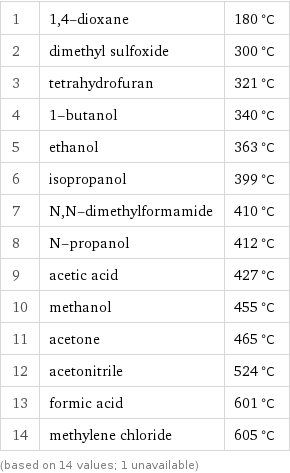Input interpretation

polar solvents | autoignition point
Summary

median | 411 °C highest | 605 °C (methylene chloride) lowest | 180 °C (1, 4-dioxane) distribution | | (based on 14 values; 1 unavailable)
Entity with missing value

water
Distribution plots

(autoignition point in degrees Celsius)
Autoignition point rankings

1 | 1, 4-dioxane | 180 °C 2 | dimethyl sulfoxide | 300 °C 3 | tetrahydrofuran | 321 °C 4 | 1-butanol | 340 °C 5 | ethanol | 363 °C 6 | isopropanol | 399 °C 7 | N, N-dimethylformamide | 410 °C 8 | N-propanol | 412 °C 9 | acetic acid | 427 °C 10 | methanol | 455 °C 11 | acetone | 465 °C 12 | acetonitrile | 524 °C 13 | formic acid | 601 °C 14 | methylene chloride | 605 °C (based on 14 values; 1 unavailable)
Unit conversions for median autoignition point 411 °C

684 K (kelvins)

772 °F (degrees Fahrenheit)

1231 °R (degrees Rankine)

329 °Ré (degrees Réaumur)

223 °Rø (degrees Rømer)
Comparison for median autoignition point 411 °C

70 °C below typical temperature of an electric oven during self-cleaning (900 °F)

84 °C above melting point of lead (327.46 °C)
Corresponding quantities

Thermodynamic energy E from E = kT: | 59 meV (millielectronvolts)

Blackbody energy flux Φ from Φ = σT^4: | 12423 W/m^2 (watts per square meter)

Approximate luminous exitance from a planar blackbody radiator perpendicular to its surface: | 2.1×10^-4 lx (lux)